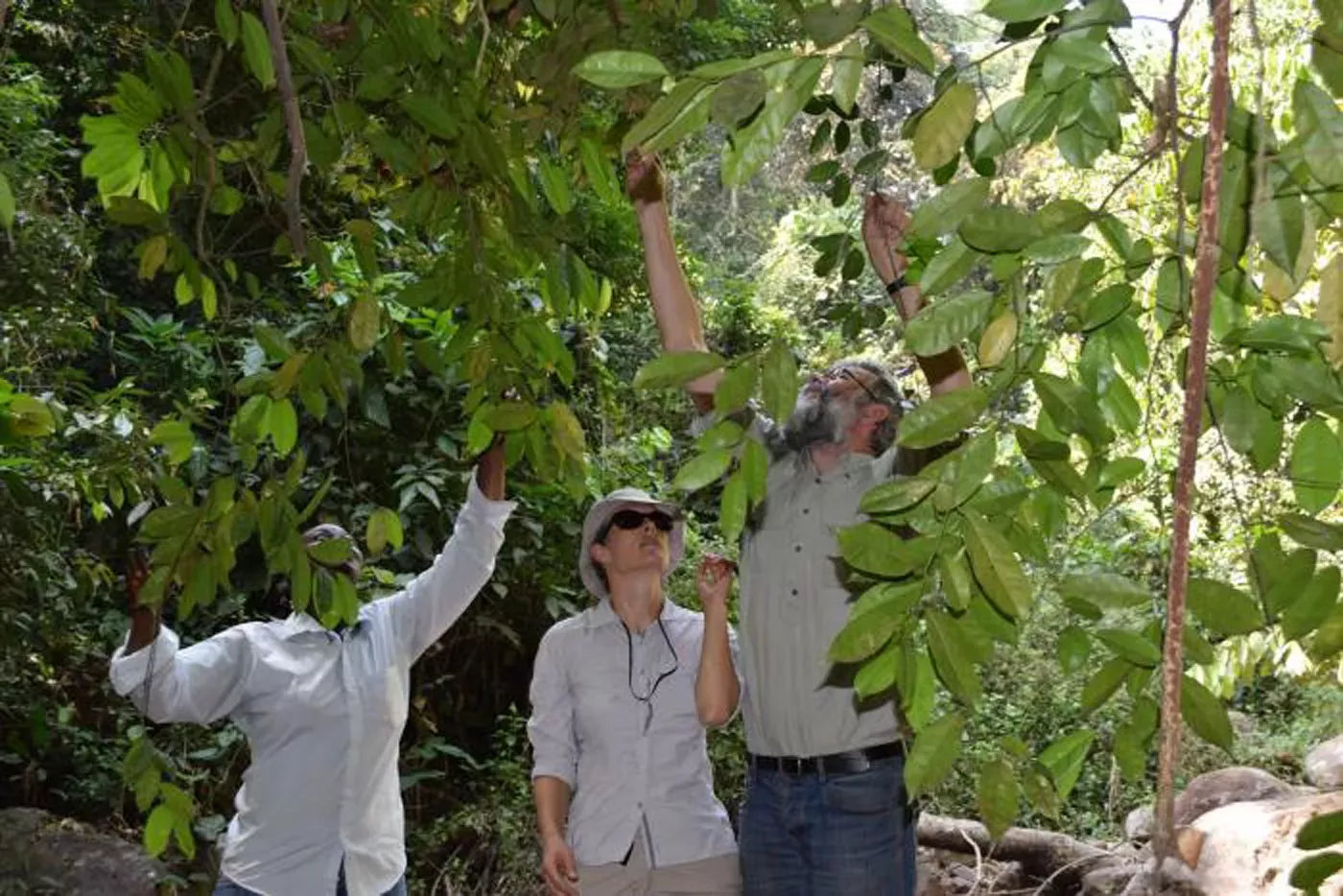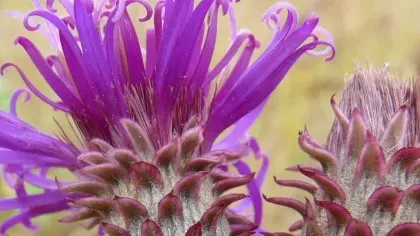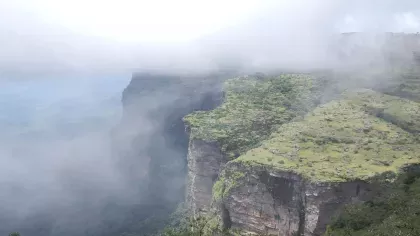1 March 2016
Training the trainers in Guinea
In February 2016, Kew Africa and Madagascar team members Martin Cheek, Charlotte Couch and Isabel Larridon travelled to Guinea in West-Africa for fieldwork and to train local botanists.

Disseminating scientific knowledge of plants in Guinea
Kew Scientists have been working in Guinea since 2005 when Rio Tinto requested a survey of their mining concession in the Simandou Range. It became apparent at this time that there was very little botanical capacity in the country and surprisingly, no national herbarium.
While Guinea now has a published Flora (a book detailing the plants of the region; Lisowski, 2009), botanical knowledge in the country is far from complete and very little progress has been made in recent decades. Kew began training local university graduates in the field in 2005 and has continued this through various consultancy projects with funding and support from Rio Tinto.
Botanical knowledge required
Guinea has numerous plant species, and several endemic genera that appear to be threatened. If Guinean botanists are to protect these species, they need to be armed with the scientific tools to identify, map, monitor and manage them. In conjunction with local partners, Kew is helping to provide this knowledge. This is particularly critical now, since most of the original forest cover in Guinea has already been removed for agriculture and development; mining of aluminium and iron ores, diamonds and gold also threaten vast areas of natural habitat.
Crucial to identifying rare wild plant species using correctly named reference specimens, a National Herbarium was set up to act as a centre for these activities. The partnership between Kew and the Herbier National de Guinée (HNG) based at the Université Gamal Abdel Nasser de Conakry, has been in place since 2008 and will continue until at least 2021.
Our recent trip to Guinea served multiple purposes. Firstly, to continue providing field training to the next generation of Guinean botanists on the rare and unique plants found in their country. Secondly, Guinea is one of the focus countries in Africa for Kew’s Tropical Important Plant Area (TIPA) programme, and we aimed to lay the foundations for future research. Thirdly, to collect seeds of threatened species for the Millennium Seed Bank. And finally, to deliver a vegetation survey training course to the Master’s students at the HNG, ensuring that they have the knowledge and skills to conduct scientific botanical surveys to assess plant diversity.
Hunting for rare endemics at Mount Gangan
The first week of our stay in Guinea was spent with local young botanists, Denise Molmou and Pepe Haba, at Mount Gangan near the town of Kindia. This area is both geologically and biologically diverse. It consists of thick sandstone formations which overlie granitic basement rock. Erosion by rain and rivers has carved deep canyons and valleys into the sandstone, where some forest patches remain, close to local agricultural farmland used for cultivation of oil palm and food crops. On the hilltops, the granite is exposed, resulting in inselbergs with very specific vegetation types. All habitats in this area are underexplored, with most of the few existing collecting records made in French Colonial times.
The area around Mount Gangan is known to hold some narrow endemic plant species. Two particularly remarkable species from this area are Pitcairnea feliciana – a narrow endemic and the only bromeliad species found outside of the Americas; and, Fleurydora felicis – an endemic genus of the Ochnaceae family only found in the Mount Gangan area. It is thought that these species are not alone in being unique to this area. In fact several interesting and possibly new species were discovered during our fieldwork in February 2016. Mount Gangan is currently not effectively protected. But it is a strong a candidate site for Kew's TIPA programme.

Training the trainers
On 29 October 2012, the Herbier National de Guinée (HNG) launched the 'Master de Biodiversité et de Développement Durable (BVD-DD’) or Master in Biodiversity and Sustainable Development, on which Kew scientists were invited to teach. This is a two year course aimed at addressing the gap between graduate students and the next generation of teachers. The herbarium staff are all too aware that undergraduate courses are becoming more generalised, and the age of the teaching professors is increasing, with few people coming up the ranks to take over. The first Master’s intake is made up of 16 students from diverse backgrounds, including seven professors of the universities of Kindia, Mamou and N’zérékoré, senior staff of the Guinean ‘Ministère de l'Environnement, des Eaux et Forêts’, and students with Bachelor’s, Master’s and PhDs in various related fields.
Their course had an unfortunate hiatus due to the Ebola virus epidemic in Guinea from 2014–2015, however the students are now set to receive their diplomas in October 2016. After a delay of a year, our six-day vegetation survey course led by Dr Martin Cheek, Prof. Isabel Larridon and Charlotte Couch finally took place. The course was a mix of vegetation survey technique lectures, practical training (including a GPS treasure hunt, setting up quadrats and sampling in the Jardin Botanique de Camayenne), and a fieldtrip to riverine forest near Coyah, at Pont Kaka to put these techniques to the test. The students then had to analyse their data and present their results to the class.

Jardin Botanique de Camayenne
The botanic garden at Camayenne was created in 1897 by French botanist Auguste Chevalier. Originally over 13 hectares, the botanic garden was meant as a test site for useful trees to be introduced for cultivation in Guinea. Now, the garden has been reduced to 7 ha to make space for the Grande Mosquée Faiçal and the Cameroon cemetery. It is currently the base of the Ministere de l’Environnement, des Eaux et Forets. The botanic garden setting allowed us to introduce field survey techniques to the students, enabling them to try out equipment like the pole pruners.
Pont Kaka riverine forest
The riverine forest at Pont Kaka near Coyah had previously been identified as a site of interest on expeditions to Kindia and beyond. There are clear indications that it is an important vestige of riverine forest with interesting species, and this site may become a future TIPA. As it sits outside the boundary of the adjacent protected Forêt Classé de Gbalan, it is currently unprotected. It is also under pressure from nearby sand extraction, wood cutting, charcoal production and pollution from plastic litter and human waste – the section closest to the road is a popular relief stop along the primary road from Guinea’s capital, Conakry.
This forest patch proved a challenging site for the students to practice their field survey techniques. As teachers, it was ideal for us to demonstrate that fieldwork can be difficult, requiring lateral thinking to tackle obstacles including steep banks, tall trees and water. A far cry from the botanic garden where setting up plots was quite straightforward.

Continuing collaboration
To cement the collaboration between Kew and the HNG, certificates of attendance were presented by Catherine Inglehearne, British Ambassador to Guinea and the Adjunct Minister for Higher Education and Scientific Research, and Dr Traore, Rector of the Université Gamal Abdel Nasser de Conakry. The Kew Africa and Madagascar team will continue to strengthen this valuable partnership through the TIPA programme, with support from HNG staff and students, and through training the next generation of plant scientists in Guinea.
References
Lisowski, S. (2009). Flore (angiospermes) de la République de Guinée. Jardin Botanique National de Belgique, Meise.



